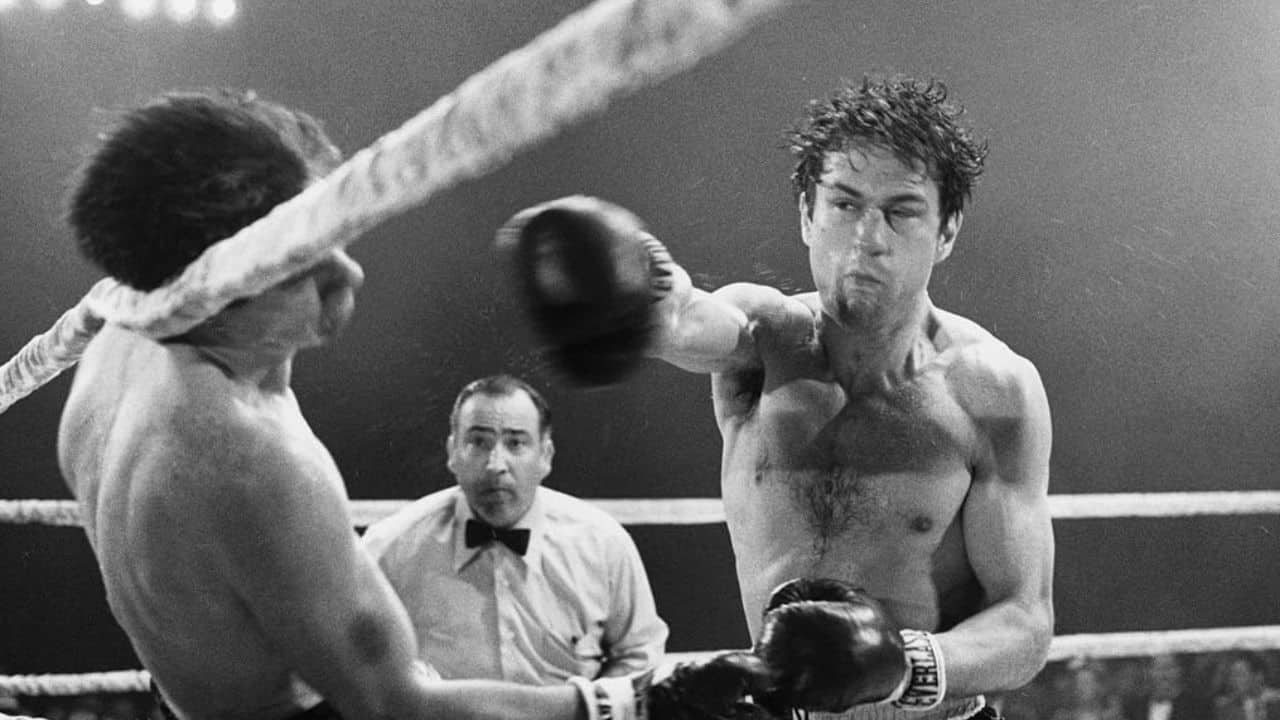The 22 Best Robert De Niro Movies

Thanks to his long and fruitful partnership with director Martin Scorsese, too many people think of Robert De Niro as a tough guy who dabbles in other genres. Without a doubt, De Niro knows how to play an intimidating figure, whether as a hired thug, a mobster, or a dictator who wants to kill a moose and a squirrel.
However, De Niro finds complex notes to play, even with otherwise similar characters. Furthermore, he’s worked in a variety of genres, showing off an impressive range, too easily overlooked by those who aren’t paying full attention.
For proof, look no further than these Robert De Niro movies that affirm his status as one of the great, living actors.
1. The Godfather Part II (1974)

Throughout his career, De Niro would step into several roles made famous by other actors. But his first and greatest challenge came in The Godfather Part II, in which he plays the junior version of Marlon Brando’s Vito Corleone.
When Brando played Corleone for Francis Ford Coppola’s first adaptation of the hit Mario Puzo novel The Godfather, the actor leaned into the theatrics. He stuffed cotton in his cheeks and made his hair gray. For the less experienced Vito, De Niro goes small, playing the immigrant as a quiet and intelligent man who observes before he acts.
However, every time that De Niro adopts one of Brando’s signature gestures, scratching his chin or extending a hand in thought, he creates a continuity between a young man learning the ways of the world and an older, more powerful man. The actor won an Oscar for his performance, cementing The Godfather Part II as one of the great Robert De Niro movies.
2. Taxi Driver (1976)

Taxi Driver wasn’t De Niro’s first important performance, but it was the first to demonstrate his commitment as an actor. To play the fanatical sociopath Travis Bickle, De Niro lost almost all body fat, trimming himself down to a lithe, wiry figure of hate.
The more diminished frame bottled De Niro’s energy, but it did not contain it. Even before Taxi Driver, directed by Scorsese and written by Paul Schrader, takes Bickle to his violent extremes, when he’s just taking fares in New York City, De Niro crackles with aimless anger.
Even after years of parodies and imitators, De Niro’s “You talking to me?” sequence still sends chills down the spines of viewers.
3. Heat (1995)

A lesser movie than Michael Mann’s masterpiece Heat would have just coasted on its star power. The buzz surrounding the film focused on De Niro and Pacino sharing the screen for the first time. However, Heat has more on its mind than mere celebrity.
Instead, Mann explores one of his favorite themes, that of a man making a hard choice, from two opposing perspectives. As driven detective Vincent Hanna, Pacino bellows about his all-consuming commitment to catching criminals. As thief Neil McCauley, De Niro captures the pragmatism of a man who knows that he might someday have to leave everything behind.
Instead of watching two great actors, De Niro and Pacino show us two desperate figures with much in common.
4. Brazil (1985)

Throughout his career, De Niro will take on comedic parts with mixed results. One of his first comedy outings remains his best, thanks to its absurd world-building.
Directed by former Monty Python member Terry Gilliam, who wrote the script with Tom Stoppard and Charles McKeown Brazil takes place in a totalitarian future England, which government employee Sam Lowery (Jonathan Pryce) dreams of escaping. These dreams appear in the form of fantasy sequences and in his involvement with a possible terrorist (Kim Greist).
Sam also takes inspiration from Harry Tuttle (De Niro), a renegade HVAC repairman. De Niro doesn’t overplay the humor of a man who resists oppression by fixing heating units, letting Gilliam’s direction point out the absurdity of the premise.
5. Killers of the Flower Moon (2023)

A half-century after their first collaboration, Scorcese and De Niro still found new modes of storytelling with Killers of the Flower Moon. Written by Eric Roth and Scorsese, based on the non-fiction book by David Grann, Killers of the Flower Moon recounts a real plot by white Americans to kill and defraud wealthy members of the Osage Nation.
De Niro plays William King Hale, the ringleader of the plot and uncle to the dim-witted Ernest Burkhart (Leonardo DiCaprio). Hale commits horrific acts throughout the film, helping Ernest and other white men murder their Indigenous wives, including Mollie Burkhart (Lily Gladstone).
And yet, De Niro never turns down his charm, letting Hale present himself as a friend of the Osage, even while he tries to annihilate them. Of latter-day Robert De Niro movies, this one shows the actor at his best.
6. The King of Comedy (1982)

Thanks to their long working relationship, Scorsese learned one thing about De Niro that most directors never understand: he’s not a natural comic. So when the director needed someone to play delusional would-be comedian Rupert Pupkin in The King of Comedy, written by Paul D. Zimmerman, he returned to De Niro.
Pupkin wants nothing more than to launch his stand-up career by appearing on Jerry Langford’s (Jerry Lewis) late-night show. In fact, he’s willing to kidnap Langford, with the help of a fellow maniac (Sandra Bernhard), and take over.
Scorsese doesn’t let viewers see Pupkin’s act until the end of the movie, which lets De Niro do what he does best and play a man so desperate for approval that he goes to extreme ends.
7. Jackie Brown (1997)

In his first two movies, writer and director Quentin Tarantino showed a talent for flashy dialogue. He learned that skill by reading crime novels by Elmore Leonard. When Tarantino adapted Leonard’s Rum Punch as Jackie Brown, the cast knew they had some fancy monologues ahead of them.
Well, everyone but De Niro, that is. While Samuel L. Jackson, Pam Grier, and Robert Forster talk up a storm, De Niro’s former inmate Louis Gara spends most of his time sitting on the couch and showing little interest in the world around him.
Where De Niro captured raw energy for some of his most famous roles, he embodies lethargy as Gara. But when Gara indulges in more of the violence that sent him to prison in the first place, he shocks the audience with his indifference toward destruction.
8. Cape Fear (1991)

Cape Fear opens with a close-up of photographs of religious icons and tyrants. From there, the camera pulls back to reveal Robert De Niro’s muscled back as his character Max Cady does pull-ups in his cell. Across his shoulders, Cady has a massive tattoo of a cross, signifying the character’s spiritual commitment to torture.
Even without composer Elmer Bernstein’s blaring recreation of Bernard Hermann’s score for the 1962 Cape Fear, adapted here by Scorsese and screenwriter Wesley Strick, viewers understand that Cady is a very bad man.
The heightened tones of Cape Fear give De Niro permission to go bigger than usual. Instead of keeping his energy tight inside, he lets explode on the screen, as in the infamous scene in which Cady unnerves Sam Bowden (Nick Nolte) and his family by laughing too loud at the movies.
9. Casino (1995)

Those who don’t pay close attention to Scorsese’s filmography often assume that he makes movies glamorizing gangsters and tough guys. But movies such as Casino, which Scorsese co-wrote with Nicholas Pileggi, reveal the truth.
De Niro plays Sam Rothstein, a very imposing casino boss for the mafia, whose power is demonstrated in a scene toward the start. With flashy filmmaking set to the Rolling Stones, Sam explains the mechanics of a card scam. In the very next moment, Sam oversees the brutal reprisal against the cheaters.
But as tough as Sam appears, Casino finds him getting in over his head with other forms of power. As Sam loses control, De Niro works levels of fear and even cowardice into his macho performance, creating a portrait of lost control.
10. Mary Shelley’s Frankenstein (1994)

After the success of Coppola’s romantic and vibrant Bram Stoker’s Dracula, director and actor Kenneth Branagh took a whack at classic horror with Mary Shelley’s Frankenstein. Casting himself as Victor Frankenstein and Helena Bonham Carter as wife Elizabeth, Branagh borrows De Niro from Coppola to play The Creature.
Screenwriters Steph Lady and Frank Darabont hew closer to the 1818 novel, losing the green-skinned mumbler from the famous Universal Pictures and Hammer Horror versions. De Niro’s Creature still has a level of grotesquery, with hideous scars and stitches on his face. But he follows the model of Shelley’s book, playing an emotionally tortured and loquacious creation.
Although Branagh goes a bit too far into the theatrics, too often reducing the horror and eroticism of the story to soapy cheese, there’s a dignity in De Niro’s Creature missing from other adaptations.
11. The Untouchables (1987)

By 1987, De Niro had played his share of mobsters, to the point that he could do it in his sleep. But with Hitchcock-obsessed director Brian de Palma at the helm and macho playwright David Mamet penning the script, The Untouchables got to put an operatic spin on a familiar figure.
Kevin Costner plays Elliot Ness in The Untouchables, a square and upright lawman who recruits the grizzled beat cop Jim Malone to help him take down Al Capone (De Niro). Along the way, De Palma indulges in all of his stylistic tendencies, including a sequence copied from the stair scene in Battleship Potemkin.
De Niro keeps pace. In his most famous scene, a grandiose speech that ends with Capone beating a man to death with a baseball bat, De Niro forces De Palma’s hyperactive camera to stay with him, exercising full control over the screen.
12. Goodfellas (1990)

Based on writer Nicholas Pileggi’s account of mobster-turned-informant Henry Hill, Goodfellas pushes De Niro to the side and lets Ray Liotta take the lead. Without question, Liotta makes the most of everything that director Scorcese and Pileggi give him, playing Hill as a blustering idiot.
However, De Niro also stands out by standing aside. Where Hill loves the glitz and the glamour of the mob life, and his pal Tommy (Joe Pesci) loves the power it gives him, Jimmy knows to stay quiet and do the work.
Scenes of Hill laughing his guts out at a party and Tommy turning violent without warning may be the standouts of Goodfellas. But anyone watching De Niro’s simple, unfussy gangster knows that Jimmy is the truly scary one.
13. Raging Bull (1980)

Martin Scorsese did not want to make Raging Bull. He hated sports and wanted to try something other than another violent movie about a cruel man. But after he and De Niro bombed with their previous picture, the unpleasant musical New York, New York, Scorsese was ready to accept his favorite actor’s advice and do Raging Bull.
Scorsese teams with Paul Schrader who, along with co-writer Mardik Martin, adapts the autobiography of Jake LaMotta, a brutal fighter inside and outside of the ring. While the black-and-white photography and kinetic boxing scenes continue to influence moviemakers, viewers can tell that Scorsese’s heart isn’t in the project.
However, Raging Bull still works because of De Niro’s committed performance. He makes no attempt to endear the viewers to LaMotta, emphasizing his brutality and emotional weakness.
14. Ronin (1998)

A title card at the start of Ronin, the film by director John Frankenheimer and writers J.D. Zeik and David Mamet, explains that “ronin” are disgraced samurai, who work as mercenaries after allowing their masters to die.
The word applies to all of the ne’er-do-wells assembled by IRA operative Diedre (Natascha McElhone), which includes a French gun expert (Jean Reno) and a KGB tech expert (Stellan Skarsgård).
However, none of the rogues embody this idea better than De Niro’s Sam. His silence indicates less toughness or a mean streak, although Sam possesses both qualities. Instead, De Niro emphasizes the deep sadness of a man without a country.
15. Mean Streets (1973)

During the opening credits of Mean Streets, home movie footage shows protagonist Charlie Cappa (Harvey Keitel) hanging around with people from his neighborhood, including his best friend Johnny Boy (De Niro). When Charlie waves at the camera, Johnny Boy steps in front of him.
That brief moment captures the change in Mean Streets director Martin Scorsese’s relationship with the two actors. Keitel was Scorsese’s first muse, the star of his previous picture, Who’s That Knocking at My Door? But in Mean Streets, Scorsese meets De Niro and finds the ideal figure for his explorations of masculinity.
Scorsese would work with Keitel again. But Mean Streets earned De Niro his first Best Supporting Actor nomination and inaugurated one of the most fruitful partnerships in cinema history.
16. The Irishman (2019)

Detractors of Scorsese’s The Irishman point to two problems with the movie, written by Steven Zaillian and adapted from the book I Heard You Paint Houses by Charles Brandt. One criticism is that the three-and-a-half-hour film goes on too long, a charge dismissed with ease.
The other, however, pertains to a scene in which De Niro, digitally de-aged to play mob enforcer Frank Sheeran as a man in his thirties, attacks a grocer. Tech magic may have removed De Niro’s wrinkles, but it couldn’t make a septuagenarian move like a thirty-year-old.
That embarrassment aside, De Niro still makes The Irishman sing. He and Scorcese once again explore the pitfall fallout of the gangster life. But De Niro brings a deep sadness to the entire affair, accentuated by his friendships with mobster Russell Bufalino (Pesci) and union boss Jimmy Hoffa (Pacino).
17. The Deer Hunter (1978)

Director Michael Camino’s mesmerizing Vietnam War epic The Deer Hunter has no shortage of outstanding performances, including an Academy Award-winning turn by Christopher Walken, a young Meryl Streep, and a perfect, as always, John Cazale.
Written by Camino and Deric Washburn, The Deer Hunter follows three friends from a Pennsylvania steel town who lose their innocence in Vietnam.
As fantastic as all the performances in The Deer Hunter are, De Niro gets the hardest part. His character Mike Vronsky serves as the emotional center of the film. As his friends die and lose their minds, Mike must watch and hold it together, bringing the story home to the audience. As a result, The Deer Hunter finds De Niro at his most generous, using his star power to highlight the strengths of his co-stars.
18. Mad Dog and Glory (1993)

It comes to the surprise of no one that De Niro plays the “Mad Dog” of Mad Dog and Glory. However, those who haven’t seen the movie, written by Richard Price and directed by John McNaughton, will be surprised to learn that Mad Dog is an ironic nickname.
Wayne Dobie gets the nickname because he’s a cop who never uses his gun, acting instead as a crime scene photographer. In an act of uncharacteristic bravery, Wayne saves the life of the true tough guy of the movie, Bill Murray’s gangster Frank Milo, who expresses thanks by sending call girl Glory (Uma Thurman) with him.
As much as that synopsis suggests that Mad Dog and Glory puts De Niro back on familiar ground, the light comedy challenges him to use a light touch. De Niro succeeds in, staying within the film’s sweet tone, instead of falling into the darker aspects.
19. The Adventures of Rocky and Bullwinkle (2000)

As suggested by the omission on this list of hits such as Analyze This and Meet the Parents, broad comedy tends to be a weak spot for De Niro. The zany settings don’t lend themselves to his skills as an intellectual and chameleon-esque performer.
But then, there’s The Adventures of Rocky and Bullwinkle, directed by Des McAnuff and written by Kenneth Lonergan (believe it or not). The movie renders the moose and squirrel from Jay Ward’s beloved 60s cartoons through CG animation. But for the human characters Boris Badenov (Jason Alexander) and Natasha Fatale (Rene Russo), McAnuff casts humans in goofy make-up.
That’s where De Niro comes in, wearing a false nose, a fake scar, and a monocle. De Niro isn’t what most would call good in The Adventures of Rocky and Bullwinkle, but he does commit to the part, even as he recreates his “Are you looking at me” monologue from Taxi Driver.
20. Midnight Run (1988)

Some might read the above entry and raise an objection to the inclusion of Midnight Run, directed by Martin Brest and written by George Gallo. After all, Midnight Run is a buddy comedy, which pairs De Niro with Charles Grodin.
However, De Niro plays bounty hunter Jack Walsh, allowing him to stay in tough guy mode, while Grodin generates the comedy as runaway accountant Jonathan “The Duke” Mardukas.
This isn’t to say Jack doesn’t get any jokes. The one-liners he tosses at an FBI agent (Yaphet Kotto) and a bail bondsman (Joegee Pantoliano) prove otherwise. However, the jokes come from the anger and energy that De Niro brings to many of his tough-guy roles, which helps him sell them.
21. Stardust (2007)

Perhaps the best pure comedy part for De Niro comes in a very unexpected place, the movie Stardust, co-written and directed by Matthew Vaughn and co-written by Jane Goldman, who adapted the fantasy romance novel by Neil Gaiman.
De Niro’s character, the pirate captain Shakespeare, seems like a natural fit for him. He and his men capture the fallen star Yvaine (Claire Danes) and Tristian (Charlie Cox), the lad who tries to protect her from the greedy witch Lamia (Michelle Pfeiffer). However, Shakespeare reveals that he does not want to pirate anymore. He’d rather dance in a boa and knickers.
Against the potential cruelty in Vaughn’s typical meathead approach, De Niro displays real sympathy and kindness toward Captain Shakespeare. He plays the sadness and hope of his character instead of going broad, inviting laughter with and not at the pirate.
22. Awakenings (1990)

Directed by Penny Marshall and written by Steven Zaillian, from the memoir by Oliver Sachs, Awakenings earned three Oscar nominations, including a Best Actor nod for De Niro. And that’s a good thing because Awakenings is what people mean when they talk about Oscar Bate.
De Niro plays Leonard Lowe, a man left catatonic for three decades after surviving a pandemic. Thanks to the pioneering techniques of Dr. Malcolm Sayer (Robin Williams), Lowe awakens from his state with a zest for life, helping other victims of the disease follow.
As much as the true story of Awakenings will inspire viewers, De Niro makes the mistake of going far too big and demeaning when portraying a disability. However, when he’s out of that state, there’s a remarkable vulnerability and warmth to his character, which almost offsets the problems of the part.





